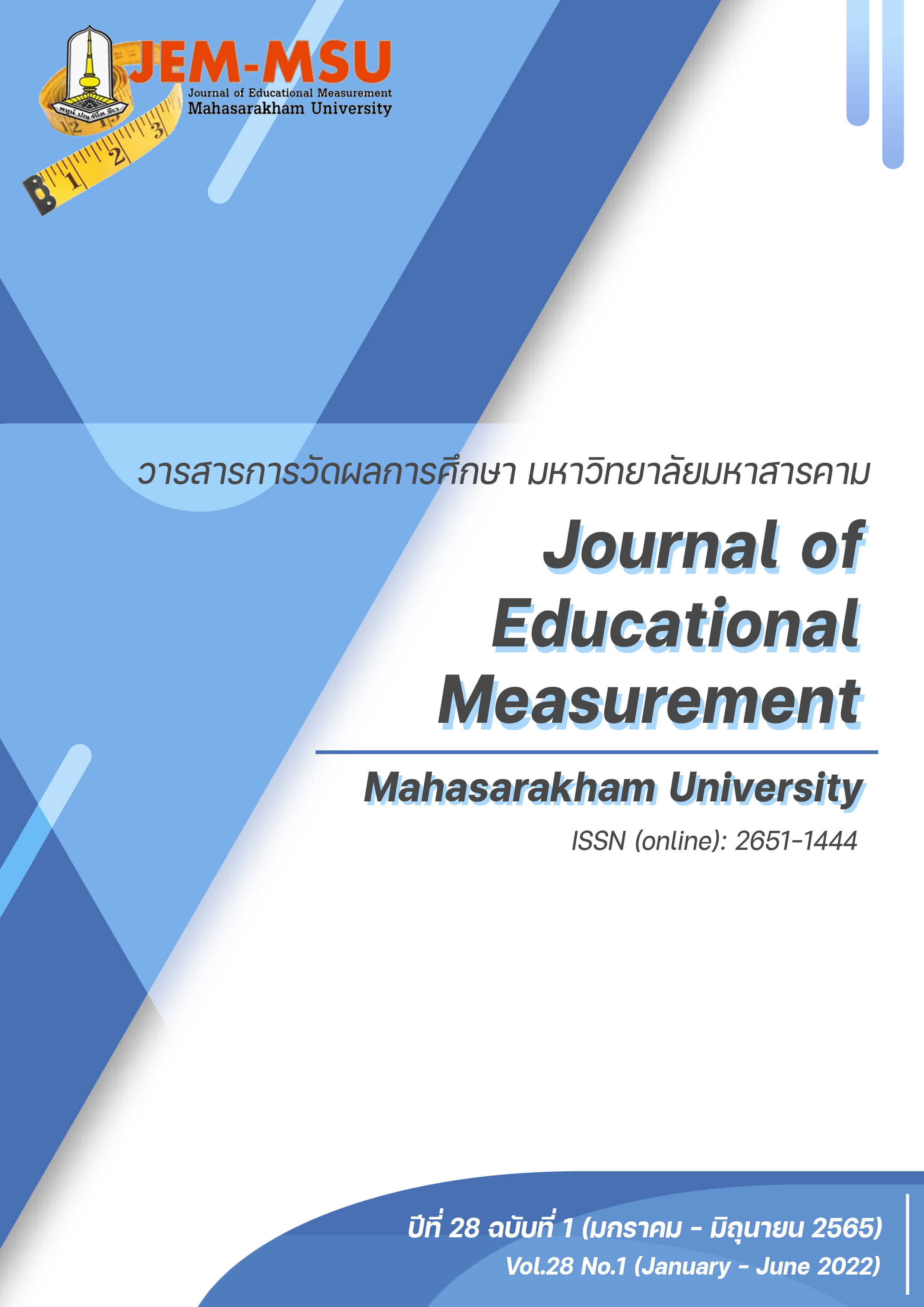การออกแบบการรายงานผลการวินิจฉัยระดับความสามารถทางคณิตศาสตร์แบบเรียลไทม์ผ่านแพลตฟอร์มการเรียนรู้ดิจิทัล
Main Article Content
บทคัดย่อ
การวิจัยครั้งนี้มีวัตถุประสงค์เพื่อวิเคราะห์ผลการตอบของผู้เรียนในการสร้างจุดเปลี่ยนผ่านระดับความสามารถทางคณิตศาสตร์แบบพหุมิติและออกแบบการรายงานผลผู้เรียนเพื่อวินิจฉัยระดับความสามารถทางคณิตศาสตร์แบบเรียลไทม์ กลุ่มผู้สอบคือนักเรียนชั้นมัธยมศึกษาปีที่ 1 จำนวน 1,559 คน เครื่องมือที่ใช้ในการวิจัย คือ แบบทดสอบปรนัย 4 ตัวเลือก สาระจำนวนและพีชคณิต, การวัดและเรขาคณิต และสถิติและความน่าจะเป็น ผ่านชุดเครื่องมือวินิจฉัยในระบบการทดสอบออนไลน์ “eMAT-Testing”
ผลการวิจัยพบว่า
1.จุดเปลี่ยนผ่านระดับความสามารถทางคณิตศาสตร์จากการวิเคราะห์ผลการตอบผู้เรียนเพื่อนำไปสู่การออกแบบการรายงานผลผู้เรียนคลอบคลุม 2 มิติ คือ มิติกระบวนการทางคณิตศาสตร์ และมิติโครงสร้างความคิดรวบยอดใน 3 สาระ โดยแต่ละสาระมีความสามารถของนักเรียนในแต่ละมิติแบ่งได้ 5 ระดับ 4 จุดเปลี่ยนผ่าน
2.ผลการออกแบบการรายงานผลผู้เรียนเพื่อวินิจฉัยระดับความสามารถทางคณิตศาสตร์ผ่านแพลตฟอร์มการเรียนรู้ดิจิทัล ประกอบด้วย 2 ส่วน คือ (1) การรายงานรายบุคคลสำหรับผู้เรียนและผู้ปกครอง ซึ่งจะแสดงข้อมูลส่วนตัว คะแนนที่ผู้เรียนทำได้ และการให้ข้อมูลป้อนกลับเพื่อบอกระดับความสามารถปัจจุบันของผู้เรียน สิ่งที่ผู้เรียนต้องพัฒนาไปสู่ระดับที่สูงขึ้น และช่องทางการศึกษาเพิ่มเติม และ (2) การรายงานการสำหรับครู สถานศึกษาและเขตพื้นที่การศึกษา ซึ่งเป็นการรายงานผลผู้เรียนในภาพรวม
Article Details

อนุญาตภายใต้เงื่อนไข Creative Commons Attribution-NonCommercial-NoDerivatives 4.0 International License.
เนื้อหาและข้อมูลในบทความที่ลงตีพิมพ์ในวารสารการวัดผลการศึกษา มหาวิทยาลัยมหาสารคาม ถือเป็นข้อคิดเห็นและความรับผิดชอบของผู้เขียนบทความโดยตรง ซึ่งกองบรรณาธิการวารสาร ไม่จำเป็นต้องเห็นด้วย หรือร่วมรับผิดชอบใดๆ
บทความ ข้อมูล เนื้อหา รูปภาพ ฯลฯ ที่ได้รับการตีพิมพ์ในวารสารการวัดผลการศึกษา มหาวิทยาลัยมหาสารคาม ถือเป็นลิขสิทธิ์ของวารสารการวัดผลการศึกษา มหาวิทยาลัยมหาสารคาม หากบุคคลหรือหน่วยงานใดต้องการนำทั้งหมดหรือส่วนใดส่วนหนึ่งไปเผยแพร่ต่อหรือกระทำการใดๆ จะต้องได้รับอนุญาตเป็นลายลักษณ์อักษรจากวารสารการวัดผลการศึกษา มหาวิทยาลัยมหาสารคาม ก่อนเท่านั้น
เอกสารอ้างอิง
Adams, R. J., & Khoo, S.T. (1996). Quest: The interactive test analysis system. Australian Council for Educational Research.
Adams, R. J., Wilson, M., & Wang, W. C. (1997). The multidimensional random coefficients multinomial logit model. Applied Psychological Measurement, 21(1), 1-23
AERA, APA, & NCME. (2014). Standards for Educational and Psychological Testing (6th ed.). American Educational Research Association.
DeMars, C. (2010). Item Response Theory: Understanding Statistics Measurement. Oxford University Press.
Junpeng, P., Inprasitha, M., & Wilson, M. (2018). Modeling of the open-ended items for assessing multiple proficiencies in mathematical problem solving. The Turkish Online Journal of Educational Technology, 2(Special Issue for INTE-ITICAM-IDEC), 142–149.
Junpeng, P., Marwiang, M., Chiajunthuk, S., Suwannatrai, P., Chanayota, K., Pongboriboon, K., Tang, K. N., Wilson, M. (2020b). Validation of a digital tool for diagnosing mathematical proficiency. International Journal of Evaluation and Research in Education (IJERE). 9(3), 665-674.
Lin, T. H. & Dayton, C. M. (1997). Model-selection information criteria for nonnested latent class models. Journal of Educational and Behavioral Statistics, 22, 249-264.
Linacre, J. M. (1994). Sample size and item calibration [or person measure] stability. Rasch Measurement Transactions, 7(4), 328.
OECD. (2019). OECD learning compass 2030. OECD Publishing. http://www.oecd.org/education/2030-project
Sass D. A., Schmitt T. A., & Walker C. M. (2008). Estimating non-normal latent trait distributions with item response theory using true and estimated item parameters. Applied Measurement in Education, 21, 65-88.
Wilson, M. (2005). Constructing measures: An item response modeling approach. Rout ledge.
Wilson, M., Allen, D. D., & Li. J.C. (2006). Improving Measurement in Health Education and Health Behavioral Research using Item Response Modeling: Comparison with the Classical Test Theory Approach. Health Educ. Res., 21, 19-32.
Wright, B. D., & Stone, M. H. (1979). Best Test Design: Rasch Measurement. Mesa Press.
Wu, M. L., Adams, R. J., & Wilson, M. R. (2007). ACER Conquest: Generalized item response modelling software. ACER Press. https://works.bepress.com/ray_adams/25/
Zapata-Rivera and Irvin R. Katz. (2014). Applying audience analysis to the design of interactive score reports. Assessment in Education: Principles, Policy & Practice, 21(4), 442–463, http://dx.doi.org/10.1080/0969594X.2014.936357


